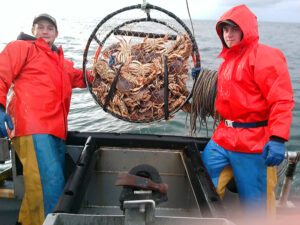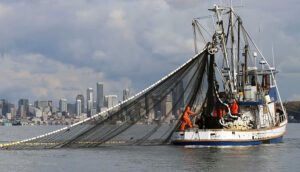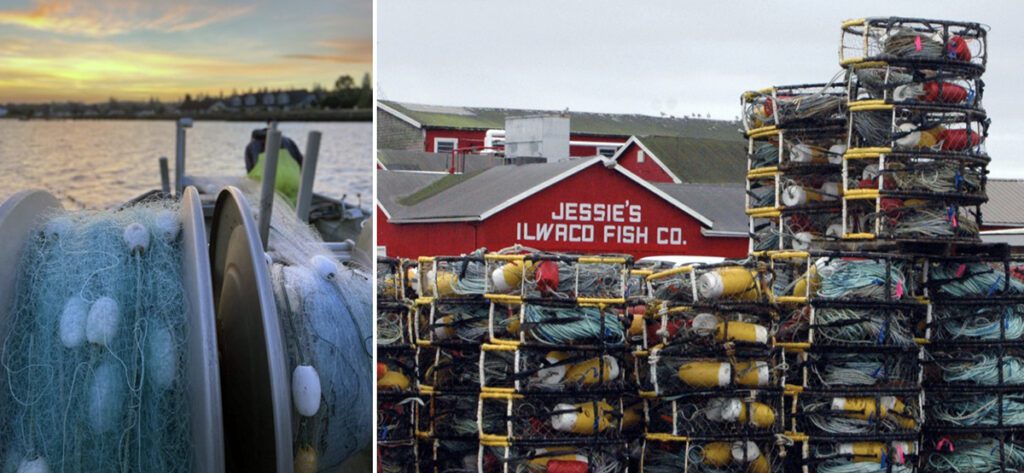
A bird’s eye view of the region’s commercial fisheries.
With 2023 behind us and a new year underway, we thought it was a good time to draw upon state, private sector and federal sources for a bird’s eye view of last year and what’s likely in store for 2024 in Pacific Northwest commercial fisheries.
For many in the salmon and albacore tuna fisheries, 2023 was a brutal year. Why? The big pain points appear to be off the water versus fish stock issues. Global markets have been shaken with the price of fish dropping and costs, like fuel, rising sharply.
A few new regulations came into effect, like the banning of lighted squid boats in Oregon and anti-whale entanglement regulations for crabbers.
But the news isn’t all bad. The Dungeness crab harvest is down a bit, but red rock crab seemed relatively stable in most areas. Oregon bottomfish grounds that have been closed since the early 2000s are opening with bullish black cod developments. There’s also a new intertidal cockle fishery in Tillamook Bay that some of you clammers might want to check out.
As always, we soldier on. This piece is published in the spirit of providing useful, accurate information, but by no means should be regarded as fishing advice. For your next move into whatever fishing season you’re targeting, you ought to listen to your gut, lean on experience and say a prayer. If you see albacore tuna fishermen, buy them a drink.

Washington: Pink and Chum Market Collapse, Spotty Puget Sound Dungeness, Albacore Woes
“The biggest surprise from 2023 was the market collapse seen in Alaska—and presumably linked to fisheries and markets on the other side of the Pacific—which had effects all the way down into Puget Sound,” Kyle Adicks of the Washington Department of Fish & Wildlife (WDFW) Fish Program said. “Pink and chum seasons in Puget Sound were not expected to be great, but the low ex-vessel prices made it an even worse year than expected for commercial salmon fishermen in Puget Sound.”
For those unfamiliar with the 2023 drama, the market price of pink and chum salmon effectively crashed. A one-page Aug. 5, 2023, letter from Trident Seafoods CEO Joe Bundrant and Senior Vice President, Alaska Operations Jeff Welbourn summarized the issue: “The current state of the salmon markets is volatile, and future indicators are even more concerning. Spring of 2023 brought a sharp decrease in wholesale prices across all species and continues to drop as weeks progress.”
The letter stated bluntly that the chum markets had collapsed, ending at 20 cents per pound, by all accounts, a disaster.

In the same letter, Trident also announced it would not participate in the Puget Sound or fall salmon fisheries at all. This was likely an attempt to put less fish on the market which would further flood the supply and decrease the price even more. The letter made a connection to Russia and the Ukraine war.
“Last week, Russia harvested pink volume equivalent to our entire Alaska pink annual forecast, and they have shown a willingness to offload inventory at very low prices in part to fund the war in Ukraine,” stated the letter. “We haven’t seen a collapse in value like this since the 1990s when pinks went well under ten cents a pound.”
Other salmon fisheries were not hit so hard. If the theory from Trident is correct, mass Russian fish selling must have been limited to pink and chum salmon. Trident states on its website that Russian fish exporters are easily dodging sanctions by way of Chinese seafood processing and distribution companies.
“The ocean troll salmon season for Chinook and coho was less affected, and North of Falcon fishers had a decent season,” Adicks wrote.
In 2023, South of Falcon was largely closed due to conservation issues with stocks. Most of WDFW’s 2024 salmon forecasts are expected out in early March at the North of Falcon public meeting, which is the kickoff to the salmon season setting process for 2024 and 2025.
What about the crab situation? Overall, the current five-year average of annual harvest in pounds for Puget Sound Dungeness crab is 15% less than the previous five-year average, including state (sport and non-tribal commercial) and tribal harvests.
“Note that there is no attempt to quantify the effort here, and there are no formal estimates of Dungeness crab abundance to point to,” Mark Yuasa of WDFW clarified. “This is simply harvest.”
Notably, the average harvests of the last five years have decreased most dramatically in Region 5, by 49%, and Region 7, by 98%.
“Of course, both regions have experienced closures of the fishery as noted,” Yuasa stated. “Pre-season test fishing data has supported the ongoing closures of Region 7 and the southern part of Region 5. Northern and central Puget Sound have historically been the most productive and stable areas of Dungeness crab harvest.”
Yuasa reported that red rock crab populations in Puget Sound appear to be relatively healthy, even where Dungeness crab populations have struggled and closures have been enacted.
Offshore, the albacore tuna season was one of the lowest producers in three decades. “Albacore landings and revenue were way down last year,” Yuasa stated. According to a Western Fishboat Owners Association (WFOA) newsletter published last September, less than 2,300 metric tons of albacore was caught on the West Coast at the time of publication.
“By comparison, over the last 20 years, the fleet has averaged over 10,500 m/t delivered,” the newsletter stated. “The average production since 2017 has been consistently lower but still near the 7,000 m/t mark, nearly three times the total so far this season.”
Explanations abound, including an El Niño weather pattern delaying seasonal production. Off-water market forces conspired to make life difficult for albacore fishermen, including high gas prices and low fish prices. Bottom line, it was a tough year for those chasing longfins.
Oregon: Squid Light Ban, Intertidal Cockles, Whale Entanglement Laws
According to Michelle Dennehy of the Oregon Department of Fish & Wildlife (ODFW), Oregon fisheries have seen a few notable changes.
First was a market squid light boat prohibition that went into effect March 18, 2023. The ban prohibits the use of lights to attract market squid, except from the catching vessel or the seine skiff of the catching vessel.
In other words, independent light boats like those used in the California market squid fishery are no longer allowed in Oregon. This is bad news for those attempting to bring that California lifestyle to Oregon’s budding squid scene.
In good news for the clam-minded among us, Tillamook Bay instituted an intertidal cockle quota effective Sept. 19, 2023.
“No more than 90,000 pounds of cockle clams may be taken for commercial purposes annually from the intertidal areas of Tillamook Bay,” Dennehy stated. “This is a fishery-wide quota harvest limit, not individual. We’ve established clam quotas for various other areas/fisheries, but this one is new.”
Whale lovers are having a moment. The Dungeness crab fishery was affected by new whale entanglement reduction measures on Aug. 8, 2023. These regulations include a 20% pot reduction starting May 1 of each season, which already has been in place for the past three years, but had been set to expire.
This action removed the sunset date to extend the law indefinitely.
The new rules also require a secondary “late season” buoy tag starting May 1 for enforcement. But that’s not all. Crabbing seaward of 40 fathoms starting May 1 of each season is now prohibited. This also had been in place since 2020, but with a three-season sunset.
The common thread here is that Oregon crabbers will need to adjust to tightening the belt every year when the whales are most active off the coast after the start of May.
Surface gear has additional limitations. No more than 36 feet of line is allowed from the front of the main buoy to the last trailer buoy and no more than three buoys total (main buoy plus two trailer buoys) are allowed.
One end marker “egg buoy” no greater than five inches in diameter attached with no more than three feet of additional line is permitted.
One pro-fisherman perk is that the new rules allow retention of crab from all derelict crab pots. “For those already holding a crab permit, and during an open season, (this rule) incentivizes removal of derelict gear by allowing them to keep crab from recovered gear,” Dennehy explained.
“This was already allowed in most situations, but these changes make the allowance universal (during open season),” she said.
Basically, finders keepers is now law. Empty an abandoned pot, keep the crab and save a whale? Sounds like a win.
The Oregon commercial salmon trolling scene was dead this year.
“As for the performance of the Oregon commercial troll salmon fishery in 2023, it was largely non-existent due to extremely low returns of Chinook salmon to California rivers (Sacramento and Klamath),” Dennehy explained.
“The fishery was only open from Cape Falcon to Humbug (Mountain) in September and October with very poor catches except for landings into Port Orford, which was about on par with a normal year,” she continued. “We also had the state waters-only fishery off the Elk River (again Port Orford), and landings were within the range of expectations. We were also open north of Cape Falcon, but landings into Oregon were below average.”
Most of the salmon stock forecasts are expected to be available from the Pacific Fisheries Management Council (PFMC) in late February to early March. The final season package should be set by April 11, 2024, at the PFMC meeting in Seattle.
2024 and Beyond: More Groundfish, Halibut Unknowns, Marine Protected Areas
“The federal allocations and regulations for the 2024 commercial groundfish fisheries will be much the same as in 2023,” Dennehy stated. “The one new piece is the passing of Amendment 32 to the Groundfish Fishery Management Plan, which opens up areas to specific types of non-trawl fishing that have been closed since the early 2000s.”
This development allows additional access to healthy groundfish stocks and more area for the directed commercial Pacific halibut fishery.
Looking ahead to 2025 and beyond, the federal limits on several key recreational and commercial groundfish stocks will be decreasing significantly (25% to 50%), particularly for petrale sole and canary rockfish.
However, the allocation for black cod is expected to increase to 300% to 400% from the 2024 allocation. So, fishermen are gaining access to more fishing grounds, but in most cases will be susceptible to tighter catch limits.
The Pacific halibut allocations for 2024 are unknown at this time and will be set by the International Pacific Halibut Commission in late January 2024. “The directed commercial halibut fishery will be set up the same as last year with three-day openings beginning at (8 a.m.) on Tuesday through (6 p.m.) on Thursday,” Dennehy said.
“The number of openings will depend on the quota available. 2024 is the second year that the National Marine Fisheries Service will be doing the permitting for Pacific halibut fisheries,” she said.
The deadline to apply for a permit for the directed fishery is Feb. 15;
the incidental with salmon troll fishery is March 1.
At the time of this writing, ODFW was working with the Ocean Policy Advisory Council (OPAC) on updating the state-level Territorial Seas Plan (TSP) prior to a Dec. 15 hearing. OPAC doesn’t have authority to manage fisheries, so an ODFW commission must adopt rules to implement council recommendations if they agree.
Assuming OPAC TSP revisions are adopted, the rules would establish six new marine protected areas with various designations and harvest restrictions along rocky shorelines, or in some cases, extending to very shallow nearshore waters.
“Most areas prohibit commercial shellfish and invertebrate harvest in the intertidal, one prohibits finfish harvest except from shore,” Dennehy explained. “Little impact is expected as there is currently very little to no commercial harvest from these areas.”
Norris Comer is a Seattle-based writer and author. His debut memoir, Salmon in the Seine: Alaskan Memories of Life, Death, & Everything In-Between is now available wherever books are sold. You can find him on Substack, Instagram and at norriscomer.com. He can be reached via email at norriscomer@substack.com.
